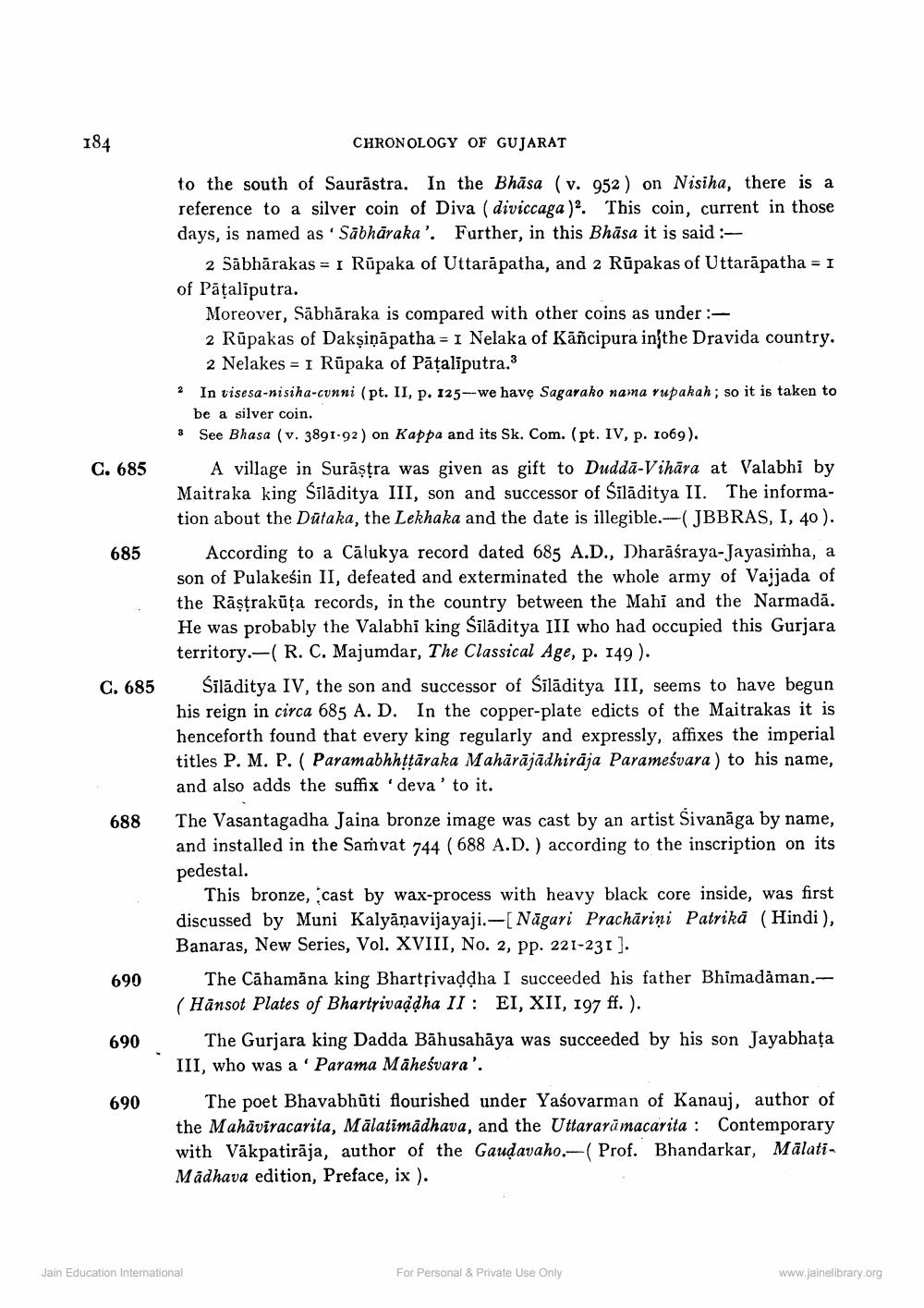________________
184
CHRONOLOGY OF GUJARAT
C. 685
685
to the south of Saurāstra. In the Bhāsa (v. 952) on Nisiha, there is a reference to a silver coin of Diva ( diviccaga )2. This coin, current in those days, is named as Sābhāraka'. Further, in this Bhāsa it is said :
2 Sābhārakas = 1 Rūpaka of Uttarăpatha, and 2 Rūpakas of Uttarāpatha = I of Pāțaliputra.
Moreover, Sābhāraka is compared with other coins as under :2 Rūpakas of Dakṣiṇāpatha = 1 Nelaka of Kāñcipura in the Dravida country,
2 Nelakes = 1 Rūpaka of Pāțaliputra. 2 In visesa-nisiha-cunni (pt. II, p. 125--we havę Sagarako nama rupakah; so it is taken to
be a silver coin. 8 See Bhasa (v. 3891-92) on Kappa and its Sk. Com. (pt. IV, p. 1069).
A village in Surāșțra was given as gift to Dudda-Vihāra at Valabhi by Maitraka king Silāditya III, son and successor of Silāditya II. The information about the Dütaka, the Lekhaka and the date is illegible.--( JBBRAS, I, 40 ).
According to a Cālukya record dated 685 A.D., Dharāśraya-Jayasimha, a son of Pulakesin II, defeated and exterminated the whole army of Vajjada of the Rāştrakūța records, in the country between the Mahi and the Narmadā. He was probably the Valabhi king Sīlāditya III who had occupied this Gurjara territory.—(R. C. Majumdar, The Classical Age, p. 149 ).
Silāditya IV, the son and successor of Silāditya III, seems to have begun his reign in circa 685 A. D. In the copper-plate edicts of the Maitrakas it is henceforth found that every king regularly and expressly, affixes the imperial titles P. M. P. ( Paramabhhttāraka Mahārājādhiraja Parameśvara ) to his name, and also adds the suffix 'deva’ to it. The Vasantagadha Jaina bronze image was cast by an artist Sivanāga by name, and installed in the Samvat 744 (688 A.D.) according to the inscription on its pedestal.
This bronze, cast by wax-process with heavy black core inside, was first discussed by Muni Kalyāņavijayaji.-[Nāgari Prachāriņi Patrikā (Hindi), Banaras, New Series, Vol. XVIII, No. 2, pp. 221-231).
The Cāhamāna king Bhartsivaddha I succeeded his father Bhimadaman.(Hānsot Plates of Bhartrivaậdha II : EI, XII, 197 ff.).
The Gurjara king Dadda Bāhusahāya was succeeded by his son Jayabhata III, who was a 'Parama Māheśvara'.
C. 685
688
690
690
690
The poet Bhavabhūti flourished under Yaśovarman of Kanauj, author of the Mahāviracarita, Mālatimadhava, and the Uttararūmacarita : Contemporary with Vākpatirāja, author of the Gaudavaho.--( Prof. Bhandarkar, MälatiMadhava edition, Preface, ix ).
Jain Education International
For Personal & Private Use Only
www.jainelibrary.org




